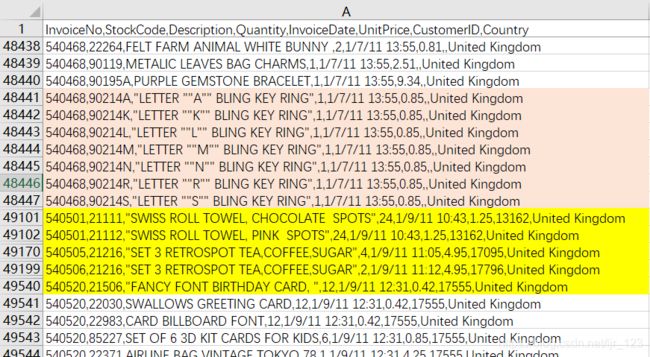- python基础练习题:超市收银系统
不爱说话的分院帽
python开发语言
这个超市收银系统包含以下功能:商品管理:支持添加和显示商品信息(ID、名称、价格、库存)购物车功能:可以添加、移除商品,查看购物车和计算总价结算功能:生成收据、处理支付、计算找零并更新库存数据模型:使用面向对象设计,包含商品、购物车和超市类系统运行后会显示菜单,用户可以通过数字选择不同操作,整个流程不需要图形界面,通过命令行交互完成购物和结算过程。importdatetimeclassProduc
- Python零基础入门:魔法方法详解
一、什么是魔法方法?魔法方法(MagicMethods)是Python中一种特殊的方法,它们以双下划线(__)开头和结尾(如__init__、__str__等)。魔法方法允许你定义类在特定情况下的行为,例如初始化、字符串表示、运算符重载等。二、常见的魔法方法分类1.构造和初始化__new__(cls,[...]):创建实例时调用的第一个方法__init__(self,[...]):实例初始化方法_
- Python文件与流处理:高效读写数据的艺术
不爱说话的分院帽
python快速入门python数据库开发语言
引言作为一名程序员,我们每天都需要与文件打交道——无论是读取配置文件、处理日志文件,还是存储程序生成的数据。Python提供了强大而灵活的文件处理能力,让这些操作变得简单高效。本文将深入探讨Python中的文件与流处理,帮助你掌握这一核心技能。、一、文件操作基础1.打开文件Python使用内置的open()函数来打开文件:#基本语法file=open('example.txt','r')#打开文件
- Python 计算月头月尾
一本正经胡说八道的猫
一本正经胡说八道的猫#!/usr/bin/envpython#-*-coding:utf-8-*-importdatetimeimportcalendartime=datetime.date(2022,1,20)#年,月,日#求该月第一天first_day=datetime.date(time.year,time.month,1)print('该月第一天:%s'%(first_day))#求前一个
- python学生成绩管理系统【完整版】,Python开发基础面试题
name=self.username.get()password=self.password.get()ifname==‘hacker707’andpassword==‘admin’:self.page.destroy()MenuPage(self.root)else:showinfo(title=‘错误’,message=‘账号或密码错误!’)db.pyimportjsonclassStuden
- 【深度强化学习】MIP-DQN 实现案例(完整Python代码)
目录MIP-DQN算法概述建模基础训练阶段(Training)部署阶段(OnlineExecution)DNN网络转化为MIP表达式性能指标完整Python代码实现主函数:random_generator_battery模型函数:MIP_DQN基础/专用库包安装模型运行(完整Python代码)参数设置函数:Parameters参考本博客根据论文《Optimalenergysystemschedul
- 【Pandas超实用经验汇总-数据建模分析】
Mr.小海
Python数据挖掘数据分析python
Pandas超实用经验汇总-数据分析前言基本方法1.读取文件2.查看数据3.修改、删除、替换数据等总结前言看见了很多教程虽然很全,但是很多技巧容易忘记且几乎用不上,读起来晦涩难懂,今天我给大家总结了Pandas的一些学习经验技巧,包含常见日常使用的pandas知识,以及一些技巧,这些技巧常见于数学建模,数据分析,数据挖掘比赛等。基本方法1.读取文件方法如下:importpandasaspd#正常写
- Go与Python在数据管道与分析项目中的抉择:性能与灵活性的较量
真智AI
人工智能pythongo
你正在设计一个全新数据管道或启动一个分析项目,此时你或许正在思考该选择Python还是Go。五年前,这甚至不是个值得讨论的问题——你会毫不犹豫地选择Python,故事到此为止。然而,近年来Go在数据领域,尤其是在数据基础设施和实时处理方面,正逐渐被更多人采用。实际上,这两种语言都已在现代数据技术栈中找到了各自的定位。Python依然非常适合机器学习和数据分析,而Go则逐步成为高性能数据基础设施的首
- Redis-py 实战指南:从安装到向量索引,Python 操作 Redis 全解析
佑瞻
数据库与知识图谱redispython数据库人工智能
在Python开发中,操作Redis数据库是很多场景下的刚需,而redis-py作为Redis官方推荐的Python客户端,更是我们绕不开的工具。但你是否在安装时踩过版本兼容的坑?是否在连接集群或配置TLS时犯过难?甚至想尝试向量索引却不知从何下手?今天我们就从基础到进阶,手把手带你玩转redis-py,让Python操作Redis变得简单又高效。一、redis-py安装:避坑指南首先,我们需要安
- Python返回函数完全指南:从基础到高级应用
Python_trys
python数据库开发语言Python教程Python技巧Python入门Python基础
包含编程籽料、学习路线图、爬虫代码、安装包等!【点击领取】前言在Python编程中,函数不仅可以执行操作,还可以作为返回值,这种特性为编程带来了极大的灵活性和强大的表达能力。本文将全面介绍Python中的返回函数,从基础概念到高级应用场景,帮助开发者掌握这一重要特性。一、返回函数的基本概念1.1什么是返回函数?返回函数指的是一个函数可以返回另一个函数作为其结果。在Python中,函数是一等对象,可
- Python爬虫实战:从新浪财经爬取股票新闻的完整实现
Python爬虫项目
python爬虫开发语言数据分析php
第一部分:爬虫概述1.1什么是爬虫?爬虫是指通过程序模拟浏览器的行为,自动化地抓取网络上的数据。通过爬虫技术,能够从各种网站上提取信息,广泛应用于数据采集、数据分析、机器学习等领域。1.2新浪财经简介新浪财经是中国最大的财经信息平台之一,提供股票、基金、债券、外汇等多方面的财经新闻和数据。在股票领域,新浪财经提供了大量的股票行情、实时数据、新闻报道等信息,因此爬取新浪财经的股票新闻对于投资分析和决
- AutoGen C#三步变强:比Python还野的多AI协作实战!
墨瑾轩
一起学学C#【四】c#python人工智能
关注墨瑾轩,带你探索编程的奥秘!超萌技术攻略,轻松晋级编程高手技术宝库已备好,就等你来挖掘订阅墨瑾轩,智趣学习不孤单即刻启航,编程之旅更有趣一、第一步:环境搭建——给AutoGen装上"AI乐高积木"目标:用C#搭建AutoGen基础环境,像组装乐高一样准备工具。步骤:克隆AutoGen项目:访问AutoGenGitHub仓库,克隆到本地:gitclonehttps://github.com/mi
- C#进行串口应用开发如何处理串口的异常情况
openwin_top
c#串口应用开发问题系列c#开发语言串口通讯上位机
python编程示例系列python编程示例系列二python的Web神器Streamlit如何应聘高薪职位C#视觉应用开发问题系列c#串口应用开发问题系列microPythonPython最小内核源码解析NI-motion运动控制c语言示例代码解析在C#中进行串口应用开发时,处理串口的异常情况是非常重要的。常见的串口异常包括端口不可用、数据传输错误、超时等
- python包管理神器【uv】详解
若叶.
pythonuv开发语言pipvirtualenv
目录1uv简介与安装1.1uv作用1.2安装方式一:github/release页下载。方式二:命令行安装(win)方式三:pypi安装确认安装成功1.3卸载2命令帮助3uv管理python版本3.1`uvpython--参数`3.2`uvpythonlist`3.3`uvpythoninstall`4uv运行单个脚本4.1`uvrun.py文件`4.2`uvinit--script`4.3`uv
- python爬虫从入门到精通
大模型猫叔
python爬虫数据库
目录一、正确认识Python爬虫二、了解爬虫的本质1.熟悉Python编程2.了解HTML3.了解网络爬虫的基本原理4.学习使用Python爬虫库三、了解非结构化数据的存储1.本地文件2.数据库四、掌握各种技巧,应对特殊网站的反爬措施1.User-Agent2.Cookies3.IP代理五、学习爬虫框架,搭建工程化的爬虫1.创建Scrapy项目2.创建Spider3.编写Spider4.运行Spi
- 从 C# 转 Python 第三天:文件操作、异常处理与错误日志实践
AI、少年郎
java前端数据库c#文件操作异常处理
在软件开发的广阔领域中,Python和C#作为两种备受瞩目的编程语言,各自凭借独特的特性和强大的功能,在不同的应用场景中展现出卓越的性能。对于开发者而言,深入理解并熟练掌握这两门语言的核心技能,如文件操作与异常处理,不仅是提升个人编程能力的关键,更是在复杂多变的项目开发中应对各种挑战、确保程序稳定运行的必备条件。在日常的编程工作中,文件操作是实现数据持久化存储、读取配置信息以及处理各种数据文件的基
- python爬虫入门(小白五分钟从入门到精通)
一百天成为python专家
python爬虫开发语言网络爬虫python3.11ipython
网络爬虫的介绍本节主要介绍Pytbon语言中支持网络爬虫的库,此外还将介绍如何获取网站的爬取规则,读者在学习和践过程中一定要严格遵守网站提供的爬取规则。网络爬虫网络爬虫通俗来讲就是使用代码将HTML网页的内容下载到本地的过程。爬取网页主要是为了获取网中的关键信息,例如网页中的数据、图片、视频等。Python语言中提供了多个具有爬虫功能的库,下面将具urHIib库:是Python自带的标准库,无须下
- Python 虚拟环境管理工具 UV:从安装到高级用法的详细教程
Dush32
pythonuv开发语言人工智能机器学习分类
前言在Python开发中,管理不同项目的依赖包和Python版本是开发者常常遇到的问题。不同项目可能依赖不同版本的库,甚至同一个库在不同版本下的行为可能不同。为了避免这些问题,使用虚拟环境成为了解决方案。虚拟环境通过隔离每个项目的依赖,避免了版本冲突问题。在Python中,常用的虚拟环境管理工具有virtualenv、venv和一些第三方工具,如UV。本文将详细介绍如何使用UV虚拟环境管理工具,从
- python并发执行_Python的并发并行[0] -> 基本概念
weixin_39940253
python并发执行
基本概念/BasicConcept快速跳转0简介与动机/WhyMulti-Thread/Multi-Process/Coroutine在多线程(multithreaded,MT)编程出现之前,计算机程序的执行是由单个步骤序列组成的,该序列在主机的CPU中按照同步顺序执行。即无论任务多少,是否包含子任务,都要按照顺序方式进行。然而,假定子任务之间相互独立,没有因果关系,若能使这些独立的任务同时运行,
- python线程嵌套线程_Python中的嵌套并行性
weixin_39923262
python线程嵌套线程
1)WhatamImissinghere;whyshouldn’taPoolbesharedbetweenprocesses?并不是所有的对象/实例都是可挑选的/可序列化的,在这种情况下,池使用的是不可挑剔的thread.lock:>>>importthreading,pickle>>>pickle.dumps(threading.Lock())Traceback(mostrecentcallla
- 移除 GIL,可显著提升 Python 多线程性能么?
AIGC开发者
python1024程序员节python开发语言
近日,一位名叫SamGross的开发者提出了一个对全局解释器锁(GIL)进行重大修改的设想。其目标在于移除CPython中的GIL,以使得多线程能够并行执行Python代码。目前,该项目已经引起了Python核心开发团队的关注。我一直在对CPython进行修改,使其能够在没有全局解释器锁的情况下运行。我想与大家分享一个可以在没有GIL的情况下运行的概念验证。这个概念验证涉及到对CPython内部的
- python 利用多进程实现文件的拷贝
AI算法网奇
python宝典python开发语言
python利用多进程实现文件的拷贝版权声明:本文为博主原创文章,未经博主允许不得转载。https://blog.csdn.net/m0_37338590/article/details/78472103整个程序的流程可分为四步:第一步是提示用户输入要拷贝的文件夹;第二步是创建新文件夹;第三步是获取文件夹中所有文件的名字;最后一步是就是利用进程池创建进程完成复制。具体的分析在程序中都有了,不再做过
- python 多线程拍照
NO1212
python开发语言
相机为basler,logicbalser相机识别条码,进行拍照args[0]为logging的参数保证log实时传输到GUI界面调用方法:main_process(args[0]).camera_run()importsysimporterrnoimportcv2importnumpyasnpimportjsonimportloggingimportthreadingimportlogging.
- python实现精确的四舍五入
mocobk
由于计算精度的问题,python无法实现真正的四舍五入round四舍五入时是遵循靠近0原则,所以-0.5和0.5进行0位四舍五入,返回的都是0round(2.135,2)-->2.13round(number[,ndigits])Returnthefloatingpointvaluenumberroundedtondigitsdigitsafterthedecimalpoint.Ifndigits
- 【Python】线程—GIL—asyncio
2401_84139049
程序员python开发语言
它们的特点和适用场景:工具特点适用场景Lock最基本的互斥锁,一次只允许一个线程访问共享资源不可重入,即同一线程再次获取会导致死锁简单的线程同步需求需要确保一段代码同一时间只能被一个线程执行RLock可重入锁,同一线程可以多次获取锁并释放允许同一线程多次调用acquire()复杂的递归线程同步需求某些情况下需要允许同一线程多次获取和释放锁Semaphore允许一定数量的线程同时访问共享资源控制并发
- 基于 Python/PHP/Node.js 的淘宝 API 商品数据抓取开发教程
在电商数据分析、竞品监控等场景中,抓取淘宝商品数据是常见需求。淘宝开放平台(OpenPlatform)提供了标准化的API接口,通过合法途径调用可高效获取商品信息。本文将分别基于Python、PHP、Node.js三种语言,详解淘宝API商品数据抓取的开发流程,并提供完整代码示例。一、淘宝API准备工作在开发前,需完成以下准备步骤:注册开发者账号访问注册账号并完成实名认证,创建应用(应用类型选择“
- python的多线程无法并行只能并发,why?
标题python的多线程无法并行只能并发,why?python的多线程无法并行只能并发,why?在Python中,特别是使用CPython解释器时,由于存在全局解释器锁(GIL),即使在多核处理器上,只有一个线程在同一时刻可以执行Python字节码。GIL会导致CPU密集型任务的线程不能真正并行执行,即使在多核机器上。这种情况下,即使你创建多个线程,CPU也会轮流为每个线程分配执行时间。只有涉及到
- 图灵python从入门到实践浮点数_Python编程 从入门到实践-图灵出品-pdf
巴黎巨星岬太郎
封面简介本书是一本针对所有层次的Python读者而作的Python入门书。全书分两部分:首部分介绍用Python编程所必须了解的基本概念,包括matplotlib、NumPy和Pygal等强大的Python库和工具介绍,以及列表、字典、if语句、类、文件与异常、代码测试等内容;第二部分将理论付诸实践,讲解如何开发三个项目,包括简单的Python2D游戏开发,如何利用数据生成交互式的信息图,以及创建
- python从菜鸟到高手电子书下载_PYTHON从菜鸟到高手 清华大学出版社
逐码追风
推荐序...1前言...3本书配套资源...5第一篇Python基础知识第1章初识Python.31.1Python简介...31.2搭建Python开发环境...81.3第一个Python程序...261.4调试Python程序...261.5小结...291.6实战与练习...29第2章Python语言基础...302.1Python程序中的基本要素...302.2数字...342.3获取用户
- Python从入门到高手9.1节-Python中的字典类型
大神薯条老师
Python从入门到高手python数据分析机器学习爬虫网络爬虫深度学习
目录9.1.1理解字典类型9.1.2字典的类型名9.1.3字典的定义9.1.4字典的主要性质9.1.5好好学习,天天向上9.1.1理解字典类型在日常生活中,我们常常会接触到“字典”这种数据类型,例如一本书籍的目录结构,在目录结构中,通过查找页码,就可以快速翻到指定的页面。如果没有这样的页码,那么我们必须从书籍的第一页开始,一页一页地查找。有了页码以后,直接翻到指定的页面。在Python中,可以通过
- PHP如何实现二维数组排序?
IT独行者
二维数组PHP排序
二维数组在PHP开发中经常遇到,但是他的排序就不如一维数组那样用内置函数来的方便了,(一维数组排序可以参考本站另一篇文章【PHP中数组排序函数详解汇总】)。二维数组的排序需要我们自己写函数处理了,这里UncleToo给大家分享一个PHP二维数组排序的函数:
代码:
functionarray_sort($arr,$keys,$type='asc'){
$keysvalue= $new_arr
- 【Hadoop十七】HDFS HA配置
bit1129
hadoop
基于Zookeeper的HDFS HA配置主要涉及两个文件,core-site和hdfs-site.xml。
测试环境有三台
hadoop.master
hadoop.slave1
hadoop.slave2
hadoop.master包含的组件NameNode, JournalNode, Zookeeper,DFSZKFailoverController
- 由wsdl生成的java vo类不适合做普通java vo
darrenzhu
VOwsdlwebservicerpc
开发java webservice项目时,如果我们通过SOAP协议来输入输出,我们会利用工具从wsdl文件生成webservice的client端类,但是这里面生成的java data model类却不适合做为项目中的普通java vo类来使用,当然有一中情况例外,如果这个自动生成的类里面的properties都是基本数据类型,就没问题,但是如果有集合类,就不行。原因如下:
1)使用了集合如Li
- JAVA海量数据处理之二(BitMap)
周凡杨
java算法bitmapbitset数据
路漫漫其修远兮,吾将上下而求索。想要更快,就要深入挖掘 JAVA 基础的数据结构,从来分析出所编写的 JAVA 代码为什么把内存耗尽,思考有什么办法可以节省内存呢? 啊哈!算法。这里采用了 BitMap 思想。
首先来看一个实验:
指定 VM 参数大小: -Xms256m -Xmx540m
- java类型与数据库类型
g21121
java
很多时候我们用hibernate的时候往往并不是十分关心数据库类型和java类型的对应关心,因为大多数hbm文件是自动生成的,但有些时候诸如:数据库设计、没有生成工具、使用原始JDBC、使用mybatis(ibatIS)等等情况,就会手动的去对应数据库与java的数据类型关心,当然比较简单的数据类型即使配置错了也会很快发现问题,但有些数据类型却并不是十分常见,这就给程序员带来了很多麻烦。
&nb
- Linux命令
510888780
linux命令
系统信息
arch 显示机器的处理器架构(1)
uname -m 显示机器的处理器架构(2)
uname -r 显示正在使用的内核版本
dmidecode -q 显示硬件系统部件 - (SMBIOS / DMI)
hdparm -i /dev/hda 罗列一个磁盘的架构特性
hdparm -tT /dev/sda 在磁盘上执行测试性读取操作
cat /proc/cpuinfo 显示C
- java常用JVM参数
墙头上一根草
javajvm参数
-Xms:初始堆大小,默认为物理内存的1/64(<1GB);默认(MinHeapFreeRatio参数可以调整)空余堆内存小于40%时,JVM就会增大堆直到-Xmx的最大限制
-Xmx:最大堆大小,默认(MaxHeapFreeRatio参数可以调整)空余堆内存大于70%时,JVM会减少堆直到 -Xms的最小限制
-Xmn:新生代的内存空间大小,注意:此处的大小是(eden+ 2
- 我的spring学习笔记9-Spring使用工厂方法实例化Bean的注意点
aijuans
Spring 3
方法一:
<bean id="musicBox" class="onlyfun.caterpillar.factory.MusicBoxFactory"
factory-method="createMusicBoxStatic"></bean>
方法二:
- mysql查询性能优化之二
annan211
UNIONmysql查询优化索引优化
1 union的限制
有时mysql无法将限制条件从外层下推到内层,这使得原本能够限制部分返回结果的条件无法应用到内层
查询的优化上。
如果希望union的各个子句能够根据limit只取部分结果集,或者希望能够先排好序在
合并结果集的话,就需要在union的各个子句中分别使用这些子句。
例如 想将两个子查询结果联合起来,然后再取前20条记录,那么mys
- 数据的备份与恢复
百合不是茶
oraclesql数据恢复数据备份
数据的备份与恢复的方式有: 表,方案 ,数据库;
数据的备份:
导出到的常见命令;
参数 说明
USERID 确定执行导出实用程序的用户名和口令
BUFFER 确定导出数据时所使用的缓冲区大小,其大小用字节表示
FILE 指定导出的二进制文
- 线程组
bijian1013
java多线程threadjava多线程线程组
有些程序包含了相当数量的线程。这时,如果按照线程的功能将他们分成不同的类别将很有用。
线程组可以用来同时对一组线程进行操作。
创建线程组:ThreadGroup g = new ThreadGroup(groupName);
&nbs
- top命令找到占用CPU最高的java线程
bijian1013
javalinuxtop
上次分析系统中占用CPU高的问题,得到一些使用Java自身调试工具的经验,与大家分享。 (1)使用top命令找出占用cpu最高的JAVA进程PID:28174 (2)如下命令找出占用cpu最高的线程
top -Hp 28174 -d 1 -n 1
32694 root 20 0 3249m 2.0g 11m S 2 6.4 3:31.12 java
- 【持久化框架MyBatis3四】MyBatis3一对一关联查询
bit1129
Mybatis3
当两个实体具有1对1的对应关系时,可以使用One-To-One的进行映射关联查询
One-To-One示例数据
以学生表Student和地址信息表为例,每个学生都有都有1个唯一的地址(现实中,这种对应关系是不合适的,因为人和地址是多对一的关系),这里只是演示目的
学生表
CREATE TABLE STUDENTS
(
- C/C++图片或文件的读写
bitcarter
写图片
先看代码:
/*strTmpResult是文件或图片字符串
* filePath文件需要写入的地址或路径
*/
int writeFile(std::string &strTmpResult,std::string &filePath)
{
int i,len = strTmpResult.length();
unsigned cha
- nginx自定义指定加载配置
ronin47
进入 /usr/local/nginx/conf/include 目录,创建 nginx.node.conf 文件,在里面输入如下代码:
upstream nodejs {
server 127.0.0.1:3000;
#server 127.0.0.1:3001;
keepalive 64;
}
server {
liste
- java-71-数值的整数次方.实现函数double Power(double base, int exponent),求base的exponent次方
bylijinnan
double
public class Power {
/**
*Q71-数值的整数次方
*实现函数double Power(double base, int exponent),求base的exponent次方。不需要考虑溢出。
*/
private static boolean InvalidInput=false;
public static void main(
- Android四大组件的理解
Cb123456
android四大组件的理解
分享一下,今天在Android开发文档-开发者指南中看到的:
App components are the essential building blocks of an Android
- [宇宙与计算]涡旋场计算与拓扑分析
comsci
计算
怎么阐述我这个理论呢? 。。。。。。。。。
首先: 宇宙是一个非线性的拓扑结构与涡旋轨道时空的统一体。。。。
我们要在宇宙中寻找到一个适合人类居住的行星,时间非常重要,早一个刻度和晚一个刻度,这颗行星的
- 同一个Tomcat不同Web应用之间共享会话Session
cwqcwqmax9
session
实现两个WEB之间通过session 共享数据
查看tomcat 关于 HTTP Connector 中有个emptySessionPath 其解释如下:
If set to true, all paths for session cookies will be set to /. This can be useful for portlet specification impleme
- springmvc Spring3 MVC,ajax,乱码
dashuaifu
springjquerymvcAjax
springmvc Spring3 MVC @ResponseBody返回,jquery ajax调用中文乱码问题解决
Spring3.0 MVC @ResponseBody 的作用是把返回值直接写到HTTP response body里。具体实现AnnotationMethodHandlerAdapter类handleResponseBody方法,具体实
- 搭建WAMP环境
dcj3sjt126com
wamp
这里先解释一下WAMP是什么意思。W:windows,A:Apache,M:MYSQL,P:PHP。也就是说本文说明的是在windows系统下搭建以apache做服务器、MYSQL为数据库的PHP开发环境。
工欲善其事,必须先利其器。因为笔者的系统是WinXP,所以下文指的系统均为此系统。笔者所使用的Apache版本为apache_2.2.11-
- yii2 使用raw http request
dcj3sjt126com
http
Parses a raw HTTP request using yii\helpers\Json::decode()
To enable parsing for JSON requests you can configure yii\web\Request::$parsers using this class:
'request' =&g
- Quartz-1.8.6 理论部分
eksliang
quartz
转载请出自出处:http://eksliang.iteye.com/blog/2207691 一.概述
基于Quartz-1.8.6进行学习,因为Quartz2.0以后的API发生的非常大的变化,统一采用了build模式进行构建;
什么是quartz?
答:简单的说他是一个开源的java作业调度框架,为在 Java 应用程序中进行作业调度提供了简单却强大的机制。并且还能和Sp
- 什么是POJO?
gupeng_ie
javaPOJO框架Hibernate
POJO--Plain Old Java Objects(简单的java对象)
POJO是一个简单的、正规Java对象,它不包含业务逻辑处理或持久化逻辑等,也不是JavaBean、EntityBean等,不具有任何特殊角色和不继承或不实现任何其它Java框架的类或接口。
POJO对象有时也被称为Data对象,大量应用于表现现实中的对象。如果项目中使用了Hiber
- jQuery网站顶部定时折叠广告
ini
JavaScripthtmljqueryWebcss
效果体验:http://hovertree.com/texiao/jquery/4.htmHTML文件代码:
<!DOCTYPE html>
<html xmlns="http://www.w3.org/1999/xhtml">
<head>
<title>网页顶部定时收起广告jQuery特效 - HoverTree<
- Spring boot内嵌的tomcat启动失败
kane_xie
spring boot
根据这篇guide创建了一个简单的spring boot应用,能运行且成功的访问。但移植到现有项目(基于hbase)中的时候,却报出以下错误:
SEVERE: A child container failed during start
java.util.concurrent.ExecutionException: org.apache.catalina.Lif
- leetcode: sort list
michelle_0916
Algorithmlinked listsort
Sort a linked list in O(n log n) time using constant space complexity.
====analysis=======
mergeSort for singly-linked list
====code======= /**
* Definition for sin
- nginx的安装与配置,中途遇到问题的解决
qifeifei
nginx
我使用的是ubuntu13.04系统,在安装nginx的时候遇到如下几个问题,然后找思路解决的,nginx 的下载与安装
wget http://nginx.org/download/nginx-1.0.11.tar.gz
tar zxvf nginx-1.0.11.tar.gz
./configure
make
make install
安装的时候出现
- 用枚举来处理java自定义异常
tcrct
javaenumexception
在系统开发过程中,总少不免要自己处理一些异常信息,然后将异常信息变成友好的提示返回到客户端的这样一个过程,之前都是new一个自定义的异常,当然这个所谓的自定义异常也是继承RuntimeException的,但这样往往会造成异常信息说明不一致的情况,所以就想到了用枚举来解决的办法。
1,先创建一个接口,里面有两个方法,一个是getCode, 一个是getMessage
public
- erlang supervisor分析
wudixiaotie
erlang
当我们给supervisor指定需要创建的子进程的时候,会指定M,F,A,如果是simple_one_for_one的策略的话,启动子进程的方式是supervisor:start_child(SupName, OtherArgs),这种方式可以根据调用者的需求传不同的参数给需要启动的子进程的方法。和最初的参数合并成一个数组,A ++ OtherArgs。那么这个时候就有个问题了,既然参数不一致,那
